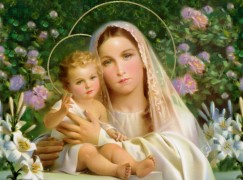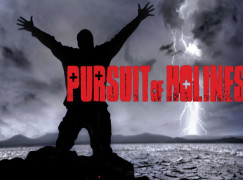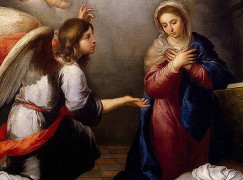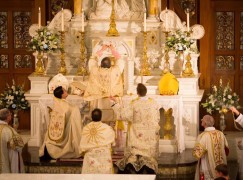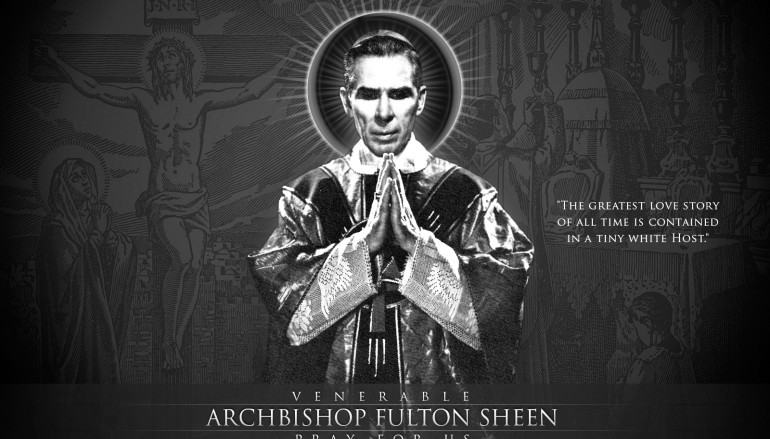

Part Six – Calvary and the Mass – The Ite, Missa Est
PART SIX – THE ITE, MISSA EST
by Archbishop Fulton J. Sheen, Ph.D., D.D., LL.D., Litt.D.
“It is finished.”-John 19:30.
OUR Blessed Savior now comes to the Ite, missa est of His Mass, as He utters the cry of triumph: “It is finished.” The work of salvation is finished, but when did it begin? It began back in the agelessness of eternity, when God willed to make man. Ever since the beginning of the world there was a Divine “Impatience” to restore man to the arms of God. The Word was impatient in heaven to be the “Lamb slain from the beginning of the world.” He was impatient in prophetic types and symbols, as His dying face was reflected in a hundred mirrors stretching through all Old Testament history. He was impatient to be the real Isaac carrying the wood of His sacrifice in obedience to the commands of His heavenly Abraham. He was impatient to fulfill the mystic symbol of the Lamb of the Jewish Pasch, who was slain without a single bone of its body being broken.
He was impatient to be the new Abel, slain by his jealous brethren of the race of Cain, that His Blood might cry to Heaven for forgiveness. He was impatient in His mother’s womb, as He saluted His recursor John. He was impatient in the Circumcision, as He anticipated His blood-shedding and received the name of “Savior.” He was impatient at the age of twelve, as He reminded His Mother that He had to be about His Father’s business. He was impatient in His public life, as He said He had a baptism wherewith He was to be baptized and He was “straightened until it be accomplished.” He was impatient in the Garden, as He turned His back to the consoling twelve legions of angels to crimson olive roots with His redemptive Blood. He was impatient at His Last Supper as He anticipated the separation of His Body and Blood under the appearance of bread and wine. And then, impatience closed as the hour of darkness drew near at the end of that Last Supper-He sang. It was the only time He ever sang, the moment He went to His death.
It was a trivial matter for the world if the stars burned brightly, or the mountains stood as symbols of perplexity, or the hills made their tribute to valleys which gave them birth. What was important was that every single word predicted of Him should be true. Heaven and earth would not pass away until every jot and tittle had been fulfilled. There was only a little iota remaining, one tiny little jot; it was a word of David’s about every prediction being fulfilled. Now that all else was fulfilled, He fulfilled that iota; He, the true David, quoted the prophetic David: “It is finished.”
That is finished? The Redemption of man is finished. Love had completed its mission, for Love had done all that it could. There are two things Love can do. Love by its very nature tends to an Incarnation, and every Incarnation tends to a Crucifixion. Does not all true love tend toward an Incarnation? In the order of human love, does not the affection of husband for wife create from their mutual loves the incarnation of their confluent love in the form of a child? Once they have begotten their child, do not they make sacrifices for it, even to the point of death? And thus their love tends to a crucifixion.
But this is just a reflection of the divine order, where the love of God for man was so deep and intense that it ended in an Incarnation, which found God in the form and habit of man, whom He loved. But our Lord’s love for man did not stop with the Incarnation. Unlike everyone else who was ever born, our Lord came into this world to redeem it. Death was the supreme goal He was seeking. Death interrupted the careers of great men, but it was no interruption to our Lord; it was His crowning glory; it was the unique goal He was seeking.
His Incarnation thus tended to the Crucifixion, for “greater love than this no man hast, that he lay down his life for his friends.” Now that Love had run its course in the Redemption of man, Divine Love could say: “I have done all for my vineyard that I can do.” Love can do no more than die. It is finished: “Ite, missa est.”
His work is finished. But is ours? When He said, “it is finished,” He did not mean that the opportunities of His life had ended; He meant that His work was done so perfectly that nothing could be added to it to make it more perfect-but with us, how seldom that is true. Too many of us end our lives, but few of us see them finished. A sinful life may end, but a sinful life is never a finished life. If our lives just “end,” our friends will ask: “How much did he leave?” But if our life is “finished” our friends will ask: “How much did he take with him?” A finished life is not measured by years but by deeds; not by the time spent in the vineyard, but by the work done. In a short time a man may fulfill many years; even those who come at the eleventh hour may finish their lives; even those who come to God like the thief at the last breath, may finish their lives in the Kingdom of God. Not for them the sad word of regret: “Too late, O ancient Beauty, have I loved Thee.”
Our Lord finished His work, but we have not finished ours. He pointed the way we must follow. He laid down the Cross at the finish, but we must take it up. He finished Redemption in His physical Body, but we have not finished it in His Mystical Body.
He has finished salvation, we have not yet applied it to our souls. He has finished the Temple, but we must live in it. He has finished the model Cross, we must fashion ours to its pattern. He has finished sowing the seed, we must reap the harvest. He has finished filling the chalice, but we have not finished drinking its refreshing draughts. He has planted the wheat field; we must gather it into our barns. He has finished the Sacrifice of Calvary; we must finish the Mass.
The Crucifixion was not meant to be an inspirational drama, but a pattern act on which to model our lives. We are not meant to sit and watch the Cross as something done and ended like the life of Socrates. What was done on Calvary avails for us only in the degree that we repeat it in our own lives.
The Mass makes this possible, for at the renewal of Calvary on our altars we are not on-lookers but sharers in Redemption, and there it is that we “finish” our work. He has told us: “And I, if I be lifted up from the earth, will draw all things to myself.” He finished His work when He was lifted up on the Cross; we finish ours when we permit Him to draw us unto Himself in the Mass.
The Mass is that which makes the cross visible to every eye; it placards the Cross at all the crossroads of civilization; it brings Calvary so close that even tired feet can make the journey to its sweet embrace; every hand may now reach out to touch its Sacred Burden, and every ear may hear its sweet appeal, for the Mass and the Cross are the same. In both there is the same offering of a perfectly surrendered will of the beloved Son, the same Body broken, the same Blood flowed forth, the same Divine Forgiveness. All that has been said and done and acted during Holy Mass is to be taken away with us, lived, practiced, and woven into all the circumstances and conditions of our daily lives.
His sacrifice is made our sacrifice by making it the oblation of ourselves in union with Him; His life given for us becomes our life given for Him. Thus do we return from Mass as those who have made their choice, turned their backs upon the world, and become for the generation in which we live other Christs living potent witnesses to the Love that died that we might live with Love. This world of ours is full of half-completed Gothic cathedrals, of half-finished lives and half-crucified souls. Some carry the Cross to Calvary and then abandon it; others are nailed to it and detach themselves before the elevation; others are crucified, but in answer to the challenge of the world “Come down,” they come down after one hour. . . two hours. . .after two hours and fifty-nine minutes. Real Christians are they who persevere unto the end. Our Lord stayed until He had finished.
The priest must likewise stay at the altar until the Mass is finished. He may not come down. So we must stay with the Cross until our lives are finished. Christ on the Cross is the pattern and model of a finished life. Our human nature is the raw material; our will is the chisel; God’s grace is the energy and the inspiration. Touching the chisel to our unfinished nature we first cut off huge chunks of selfishness, then by more delicate chiselings we dig away smaller bits of egotism until finally only a brush of the hand is needed to bring out the completed masterpiece a finished man made to the image and likeness of the pattern on the Cross. We are at the altar under the symbol of bread and wine; we have offered ourselves to our Lord; He has consecrated us.
We must therefore not take ourselves back, but remain there unto the end, praying unceasingly, that when the lease of our life has ended and we look back upon a life lived in intimacy with the Cross, the echo of the Sixth Word may ring out on our lips: “It is finished.”
And as the sweet accents of that Ite, missa est reach beyond the corridors of Time and pierce the “hid battlements of eternity,” the angel choirs and the white-robed army of the Church Triumphant will answer back: “Deo gratias.”


